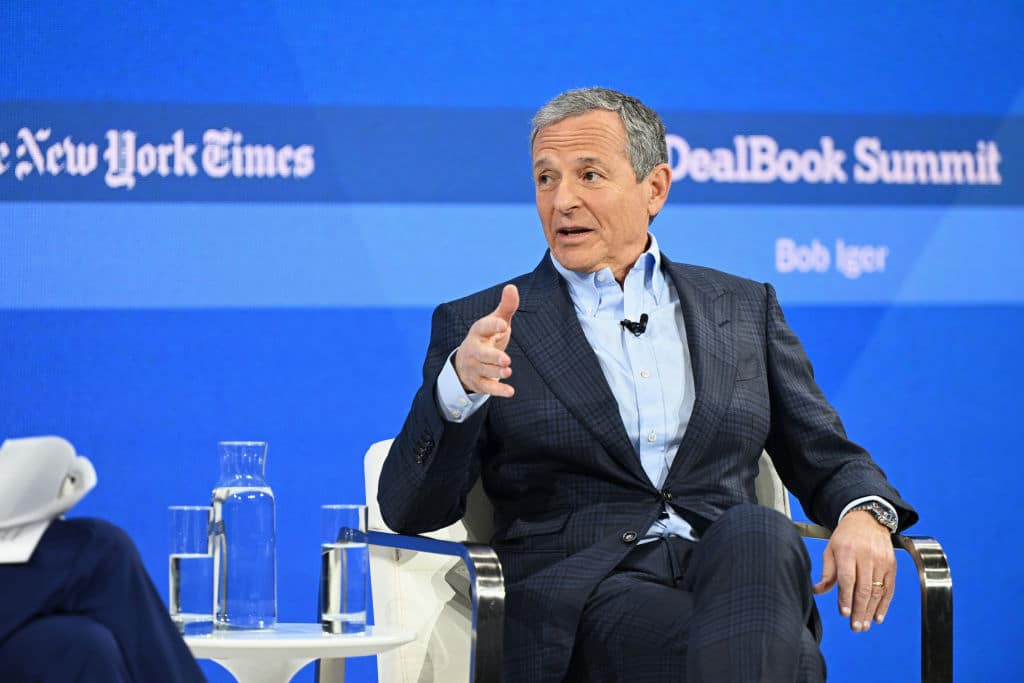
Disney has offered more details about Disneyland Abu Dhabi, the company’s first-ever theme park & resort complex in the Middle East, on Yas Island in the capital city of the United Arab Emirates. This post offers the explanation from CEO Bob Iger and Parks Chairman Josh D’Amaro about why the UAE was chosen for the next castle park, along with our color commentary.
Shortly after the original announcement, Iger and D’Amaro have gone on a media blitz with appearances on CNBC, Good Morning America, CNN–and perhaps elsewhere I haven’t seen. In addition to that, the Walt Disney Company hosted its second quarter 2025 fiscal year earnings call and shared more details, while also answering analyst and Wall Street investor questions.
All of this paints a very clear picture of why the United Arab Emirates, as opposed to other locations, for the seventh Disney theme park & resort complex in the world. So if you’re wondering why Disneyland Abu Dhabi is coming before parks in Australia, Vietnam, Indonesia, Brazil, Texas or [insert country/state of your choosing–I’ll go with Michigan], this should offer explanation.
In response to an analyst inquiry, Iger shared that the choice of the United Arab Emirates and Disneyland Abu Dhabi was the result of evaluating regional demand and long-term business opportunity.
Bob Iger gave a long and detailed answer, which I’ll simply share in full:


“On the Abu Dhabi question, which is a good question, Stephen, because we did study the region very carefully and we know that we had many opportunities. Obviously, building a theme park in a location is a huge endorsement of that location speaks volumes in terms of the ability of that location to sustain the Disney theme park.
I should start really with an overview of the Middle East. It was very obvious to us that there were many people — basically hundreds of millions in the world that are income qualified where a trip to one of our six locations was pretty lengthy in nature and expensive. And so, we felt the best way obviously to reach those people is to basically bring our product to them.
Interestingly enough, as an aside, when we decided to build a cruise ship and put it in Singapore, which will not launch until the end of the year, we put it on sale just a few months ago and the first quarter sold out in a matter of days as a for instance. So there’s clearly a desire to engage consumers with Disney in a wide region that is actually distance enough from our other locations so that we don’t really view this as in any way cannibalistic to the places we already operate.
Then when you look at Abu Dhabi and the United Arab Emirates, I mentioned these statistics earlier today. We talk about it being at crossroads of the world, 500 million income qualified people live within 4 hours, 120 million people will come through Dubai and Abu Dhabi this year alone. Abu Dhabi estimates that 39 million tourists will visit Abu Dhabi by 2030, that says a lot.”


“Then as we started to really dig deeper into Abu Dhabi specifically and engage with our partners, obviously, capital was not an issue. But in addition to that, they’ve demonstrated a number of things that were really important to us. One, a real appreciation of quality and innovation and appreciation of the arts and creativity and a huge commitment to new technology. And we were impressed with all of that.
We also looked at what they’ve already built between the Louvre that’s already built, the Guggenheim which is going up and incredible other experiences, the architecture here as well. And everywhere we look, we basically were convinced that this was a perfect place for us.
And then in Miral, our partners, we immediately bonded with them in many respects, spoke the same language and basically, we both have a real appreciation of our history and our legacy, but moving forward and being forward thinking and innovating is also part of our basically our DNA.
And so, it was very, very clear to us that of all of the places that we could choose from, there didn’t seem to be any place that was better than this. And one of the reasons why I came together so quickly is because of how convinced we became, particularly after engaging with our partners that this was the right choice.”


Our Commentary
It probably goes without saying at this point, but Iger is a smooth operator and is obviously going to give a diplomatic answer. As a third party, I can cut to the chase and offer the more straightforward explanation: money.
As we wrote previously in Disney Parks in New Countries “Inevitable” when assessing this rumor and our decision not to dismiss it out of hand: “The difference with the UAE is that there’s a very realistic scenario involving one of the country’s sovereign wealth funds. They could have backed up a money truck to Disney and CEO Bob Iger might view this as one last big legacy project. Stranger things have happened.”
To put a finer point on it, here’s a dramatic reenactment of the original meeting between Disney and Miral:
The UAE has been focusing heavily on diversifying its economy from oil as part of a long-term strategy to reinvest its oil fortunes for the inevitable decline of the fossil fuel industry and its reserves. Kind of like how Philip Morris has invested heavily in other industries in preparation for a smoke-free future.
Or perhaps more aptly, how Disney was willing to operate Disney+ at a loss for several years. Remember all those quarters that they reported hundreds of millions of dollars to over one billion dollars in losses on the streaming side? All the while domestic theme parks overperformed thanks to pent-up demand, but still had projects cut or slow-rolled?!
Disney used the revenue generated by its theme parks and slowly-dying but cash-positive legacy businesses to build what they thought/think is the future of media. Jury is still out on the wisdom of that approach, but the salient point is that Disney lost billions of dollars on streaming for years in a gamble on its future.
It’s a somewhat similar story with Abu Dhabi’s Tourism Strategy 2030. The long-term plan is massive growth for the travel & leisure sector. That comes with an extreme willingness to spend money–and lose tons of it!–right now in the hopes that in the 2030s and beyond, they will see a massive boom.
They’re willing to invest tens of billions of dollars, with no real immediate ROI, as a gamble on the future. And Disneyland Abu Dhabi will be the marquee or flagship offering to that plan. If Yas Island were a mall, Disneyland Abu Dhabi would be the subsidized anchor tenant that gets well-heeled international tourists to book trips.


Despite theme parks & resorts being a growth engine, Disney is much more conservative with its own investments in the Experiences division (e.g. the ones made without other people’s money). There are no big swings or bold bets to speak of in the 10-year “turbocharged” plan.
As opposed to building brand-new theme parks in the United States, Disney is investing in new lands in the existing gates. And honestly, calling those new lands is a bit of a stretch–they are largely redevelopments of existing parcels of “underutilized” capacity to increase efficiency.
That’s why we’re seeing growth via cruise ships as the primary expansion avenue for new international locales. That model is more nimble and dynamic, and less risky than building physical infrastructure on foreign land. If the economy or political climate sours at one of the home ports of a Disney Cruise Line ships, relocation is pretty simple and fast.


So what’s different here that caused Disney to make such a bold and unexpected move with Disneyland Abu Dhabi?
It is not a big swing. At all. They’re spending other people’s money. Disneyland Abu Dhabi will operate under a licensing model. Miral will fully fund, develop and build the resort, and run its operations once the park opens. Disney provides use of its intellectual property while being paid royalties on that and everything else. Imagineering will lead creative design and lend its operational oversight and expertise to provide a world-class experience, while ensuring the complex meets brand standards.
Iger further elaborated during the Q&A: “We own our IP and license it to them is essentially the arrangement. We’re responsible for design and development and we will be involved significantly in oversight of their operations basically to ensure that the Disney experience going — meaning the Disney theme park experience is up to the level that we offer in the other six locations that we operate.
By the way, we’re not concerned about that at all. [Miral] has already demonstrated a commitment to quality in that regard. But this is essentially a license arrangement, but with considerable involvement of us. So although, they will operate it, we will have employees embedded in the organization with them to help them operate a Disney theme park basically at the quality level that everybody is used to.”


Disney’s new 10-Q filing confirms this: “During the third quarter, the Company and Miral LLC, a limited liability company organized under the laws of the United Arab Emirates (Miral), agreed to create a Disney-branded theme park and resort in Abu Dhabi, United Arab Emirates, to be built and operated by Miral. The Company will license its IP for the operation of the theme park and resort and provide certain development and management services to the project. The Company will earn royalties based on the project’s revenues and it will also earn service fees. The Company will not provide capital for the project. The development of this project is subject to finalizing additional agreements among the parties.”
That filing still doesn’t provide complete details about the relationship specifics, noting that not everything has been finalized. Nevertheless, it’s our understanding that Disneyland Abu Dhabi will follow the Tokyo Disney Resort model, where Oriental Land Company (OLC) owns and operates the parks. During a couple of different interviews, this is the comparison that Iger and D’Amaro have made, while noting that each relationship looks a little different.
In other words, Disney is not providing any capital for the creation of Disneyland Abu Dhabi. Zero, zip, zilch, nada, nothing. This does not impact the development of any existing projects at Walt Disney World, Disneyland, or Disney Cruise Line that have been previously announced as part of the $60 billion ‘turbocharged’ investment over the next decade.
In fact, Iger reiterated twice during the earnings call that the company still has plans to invest more than $30 billion in its existing theme parks in Florida and California “to enhance those offerings, create jobs and support the U.S. economy.” Iger called this a “vote of confidence” in both Walt Disney World and Disneyland.


From a guest-facing perspective, the Tokyo parks are pure Disney magic–arguably the purest form. The parks are paid for by a third party with deeper pockets (or at least more competent decision-making and resource allocation) and Imagineering is the exclusive contractor for design work.
Meanwhile, Disney oversees everything to make sure the parks are up to the company’s standards. The result is that the Tokyo parks are arguably the best managed in the world, with the highest standards and quality. It’s a win-win approach with much more accountability.
Disney earns royalties on all revenue generated at Tokyo Disney Resort. The precise agreement and amount of the royalties are not publicly disclosed in earnings reports by OLC or Disney, but were revealed to be 10% of ticket sales and 5% of in-park purchases in the 1980s. (It’s unclear whether there was a renegotiation for the second gate.)
The best case scenario is that Disneyland Abu Dhabi is more of the same–another Tokyo DisneySea. Even if it doesn’t approach that level of themed design, attraction quality, or operational attention-to-detail (and my guess is that it won’t–Japan is a different beast), it’s still a nice payday for Disney.


Whatever deal OLC might’ve gotten in the 1980s is probably not the same as the one Miral would get today.
The biggest difference is that Japan in the 1980s is not the same as United Arab Emirates in the 2020s. Disney is also a different company; a bigger one, with the resources to tackle more projects and without the need for cash flow to nearly the same extent. All of this is to say that I strongly suspect the UAE and Miral made Disney and Bob Iger an offer they couldn’t refuse (not in the mafia sense), with a sweetheart deal that made the company willing to overlook…well, let’s just say “a lot.”
So if you’re still wondering why Disney chose to build Disneyland Abu Dhabi over Disneyland Jakarta (or wherever), it comes down to money and risk. A ton of the former and none of the latter–at least, not in the financial sense. If one of the governments or sovereign wealth funds in another location where it might make sense to build a Disney park offered a similar deal, I would hazard a guess that Disney would likewise take it.
But in the absence of such a deal? Not a chance. It is simply too risky, and runs counter to the approach that Disney has clearly identified for its Parks & Resorts expansion plans. Even a business model more on par with Shanghai or Hong Kong, where Disney partners with a state sponsor (approximately) 50/50 on investments and income, would not be nearly as desirable at this moment in time.


Ultimately, the financial arrangement with Miral to build Disneyland Abu Dhabi should be viewed as a positive one for investments and expansion at Walt Disney World and Disneyland. This very clearly does not reallocate monetary resources from Florida and California to the international parks.
To the contrary, it could easily be argued that the cash flow from royalties (plus whatever upfront lump-sum payment, if any) can be used to help fund the domestic gates. It’s basically the exact opposite of the streaming services model! It’s entirely possible that the Miral partnership will be history ‘rhyming’ with what happened in the 1980s.
Back then, the partnership with OLC to create Tokyo Disneyland gave Disney a revenue stream to endure the early, rocky years of EPCOT Center, fund future expansion, and ultimately propelled the company into becoming the behemoth it is today. Looking back today, it’s easy to say Disney should’ve built Tokyo Disneyland on their own, but the contemporaneous circumstances and risks were very different.
Will we look back on Disneyland Abu Dhabi in 40 years and say it’s obvious that Disney should’ve bet big and spent the money to build it themselves? Possibly, but I doubt it–and it’s not like that’s an actual option in the here and now. The cost-free approach to a park in the Middle East is definitely the safest path forward for myriad reasons.


This is not to say there won’t be other, non-monetary costs of Disneyland Abu Dhabi. There are reputational risks, of course. There’s also the possibility that this doesn’t come to fruition, despite Miral having a superlative track record thus far with Yas Island–far better than graveyard of abandoned Middle East theme park plans.
The biggest cost might actually be in terms of talent. Imagineering has been rapidly staffing up in Florida and California just to handle the domestic projects already on their plates. Now within the span of a week, OLC has announced intentions for major expansion to Tokyo Disney Resort and now there’s the big reveal of Disneyland Abu Dhabi. Could Imagineering’s top talents be spread too thin? That’s a distinct possibility–and a topic we’ll try to tackle soon.
Need Disney trip planning tips and comprehensive advice? Make sure to read Disney Parks Vacation Planning Guides, where you can find comprehensive guides to Walt Disney World, Disneyland, and beyond! For Disney updates, discount information, free downloads of our eBooks and wallpapers, and much more, sign up for our FREE email newsletter!
Your Thoughts
What do you think of Disney’s decision to create Disneyland Abu Dhabi? Was this the correct financial decision for Disney, or do you still think they should’ve invested their own money to build a new park in Michigan? Should it cement Disney as a theme parks business, first and foremost, as opposed to a media company? Do you think we’ll see a new castle park in our lifetimes after Disneyland Abu Dhabi? Where is your dream location for a Disney theme park–either close to home or your favorite travel destination?










